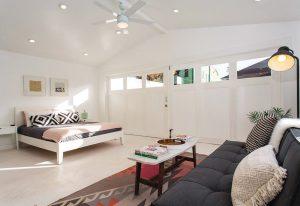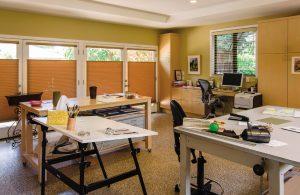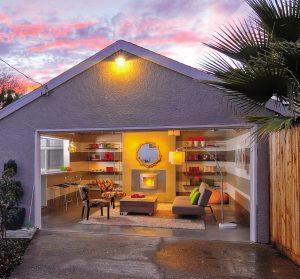 In this day and age, families are growing, storage options are shrinking, and the ongoing pandemic has called us to rise from our cramped kitchen tables and spread out into practical home offices. Instead of constructing an addition or moving into a new house altogether, consider an easier and more creative alternative—transforming your garage. A converted garage can serve as an additional bedroom, a lounge area, or a simple utility room. In fact, we converted the garage in my childhood home many years ago. Built in the 1940s, the quaint 3 bed/1 bath was a mere 1,300 square feet equipped with a powder room. As kids, we were able to get away with bunk beds and divided closets, but by the time high school rolled around, we were desperate to spread out. We opted to clear out the garage and give my brother the newly converted bedroom while my sister and I disentangled ourselves from out of each others’ hair and moved into separate bedrooms. There was peace in our household once more. If any of these situations sound familiar, here is a guide to the ins-and-outs of transforming your garage, including room preparation, design directionality, creative furniture options, and space-saving solutions.
In this day and age, families are growing, storage options are shrinking, and the ongoing pandemic has called us to rise from our cramped kitchen tables and spread out into practical home offices. Instead of constructing an addition or moving into a new house altogether, consider an easier and more creative alternative—transforming your garage. A converted garage can serve as an additional bedroom, a lounge area, or a simple utility room. In fact, we converted the garage in my childhood home many years ago. Built in the 1940s, the quaint 3 bed/1 bath was a mere 1,300 square feet equipped with a powder room. As kids, we were able to get away with bunk beds and divided closets, but by the time high school rolled around, we were desperate to spread out. We opted to clear out the garage and give my brother the newly converted bedroom while my sister and I disentangled ourselves from out of each others’ hair and moved into separate bedrooms. There was peace in our household once more. If any of these situations sound familiar, here is a guide to the ins-and-outs of transforming your garage, including room preparation, design directionality, creative furniture options, and space-saving solutions.
 When transforming your garage, an important first step is clearing out the room. This is a great opportunity to do some deep cleaning and rid yourself of the clutter that accumulates year after year. Once you are reduced to the essential items and the room is emptied, you can perform the next step: sealing and coating your garage’s concrete floor. Over time, concrete floors are easily stained with oil, antifreeze, gas, dust, and other household chemicals. Sealants are epoxy applications that fill in cracks in the concrete and protect from moisture penetration. Sealants and coatings can strengthen and protect against damage to your garage floor. They can be applied manually or with the service of a concrete sealing company. Hiring a concrete sealing company can save you time and energy and give you a precise and quality job done by skilled professionals with knowledge of codes and regulations. Professionals can provide efficient project management that gets the job done in a timely manner and fashion and ensured safety when it comes to spotting and addressing aesthetic or structural damage. If you choose to apply a sealant yourself, first clean the floor’s surface well and remove all loose debris. Sealed stains are much harder to remove, and loose debris may prevent the sealant from attaching completely to the surface. Be careful of over-application, which can result in white residue or a flaky and bubbly appearance. Finally, apply the topical coating for the added element of shine or color.
When transforming your garage, an important first step is clearing out the room. This is a great opportunity to do some deep cleaning and rid yourself of the clutter that accumulates year after year. Once you are reduced to the essential items and the room is emptied, you can perform the next step: sealing and coating your garage’s concrete floor. Over time, concrete floors are easily stained with oil, antifreeze, gas, dust, and other household chemicals. Sealants are epoxy applications that fill in cracks in the concrete and protect from moisture penetration. Sealants and coatings can strengthen and protect against damage to your garage floor. They can be applied manually or with the service of a concrete sealing company. Hiring a concrete sealing company can save you time and energy and give you a precise and quality job done by skilled professionals with knowledge of codes and regulations. Professionals can provide efficient project management that gets the job done in a timely manner and fashion and ensured safety when it comes to spotting and addressing aesthetic or structural damage. If you choose to apply a sealant yourself, first clean the floor’s surface well and remove all loose debris. Sealed stains are much harder to remove, and loose debris may prevent the sealant from attaching completely to the surface. Be careful of over-application, which can result in white residue or a flaky and bubbly appearance. Finally, apply the topical coating for the added element of shine or color.
Next, there is the option of sealing the garage door. While most opt to have the door shut and converted into another wall, some enjoy having the option of opening and closing their garage door for fresh air and natural light. An alternative is to install large windows in the door’s place, which offers the breezy feel of natural light with the security of a barrier between your home and the outside. A middle ground option with a classic look is to convert the garage door into a wall and install French doors, which provide plenty of light and a secure entrance/exit. With the right blinds or window tinting, one can only see in from the street at night, allowing the natural light to pour in with protection from wind and critters. Also, blinds or blackout curtains can be draped over the doors to exclude any unwanted illumination or prying eyes.
One of the final steps in room preparation is to consider your cooling and heating options. In order to keep this newly converted interior space cool in the summer and warm in the winter, especially if converting the room into a bedroom, you will likely want to add air conditioning to the space. When it comes to A/C, there are three options. First, you can expand the existing HVAC system so that there are air ducts in the garage, making the room part of the central system. A second option is to add a simple detached unit. This cooling and/or heating unit is self contained and can be mounted in either a wall or window. Either way, detached units make for easy installation and relocation since both the vent and compressor are located in a single box, so you don’t have to make room in the wall or ceiling for air ducts. For smaller budgets and spaces of about 500 square feet, the detached unit is best. However, it has a higher noise output than other units, can obstruct the room’s natural light if mounted in a window, and can raise your electric bill when the weather is especially warm. In other words, what may be cost-effective in installation can be more expensive in utility costs. The third option is to add a mini-split HVAC unit. Like the detached unit, the mini-split is mounted on the wall; however, the air vent remains indoors while the compressor sits outdoors like a central system. While mini-splits are more expensive than detached units, they cool a space as large as a two or three car garage, create minimal noise, and offer the same HVAC level of comfort.
In addition to indoor cooling and heating, the room may require indoor lighting to be installed. When installing your overhead lighting, consider a ceiling fan with lights. Lighted ceiling fans not only provide extra ventilation, but they also act as an added statement to your lighting fixture. Ceiling fans require little maintenance, are energy saving, and come in a variety of colors, sizes, designs, and materials to match your aesthetic. The size of the fan needed depends on the size of the room.
Converted garages can serve multiple purposes, such as additional bedrooms, recreational spaces, home offices, utility rooms, or multi-purpose studios. Once the direction of your converted garage is decided, you can begin to focus on furniture and design. One of the best pieces to incorporate is built-in furniture. Whether this new room will be used as a lounging area or a practical space, built-in furniture is a stylish space saver that maximizes storage potential while taking up little room itself. This can be done in a number of creative ways. For example, lounging spaces, such as bedrooms, can benefit from built-in bookshelves and built-in or lofted bed frames. A fold down bed can also provide a multi-purpose space when visitors come. Practical spaces, such as home offices, can benefit from long tables, shelves, and filing drawers built into the wall. A long table can function as a work desk or crafting table, and if you choose to replace your garage door with large windows, the natural light allows for a welcoming workspace. When it comes to furnishing and designing your converted garage, storage solutions range from DIY to full service contracting.
In addition to built-in furniture, converted garages can also benefit from utility closets. These built-in closets can house bulkier essential items, such as bicycles, winter gear, and seasonal decorations, or smaller items like childhood toys and books. You can also stack and place your washer and dryer inside a built-in utility closet with storage shelves and coat hooks. Sliding barn doors are a chic way to hide and disguise the appliances, reducing the loud rumbling to the peaceful humming of white noise.
Hopefully, this guide has led you one step closer to reclaiming some coveted household space. Transforming your garage is a practical way to recycle and repurpose a great room once forgotten. It is a unique project with endless potential that transforms a cluttered room into a warm and welcoming space. ![]()
Andrea Lopez
Home & Yard Magazine





